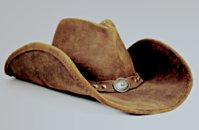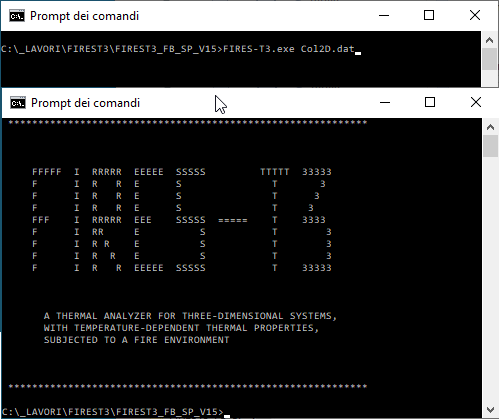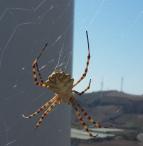CODICE
Heading:
012345678901234567890123456789012345678901234567890123456789
*** INTERIOR BASEMENT COLUMN - BLDG STUDY - ASTM FIRE ***
Word "NODES",
Number of nodal points, [NUMNP]
Number of nodal points with a specified temperature boundary condition [NTBC]
NODES,96,0
Nodal point number [N] <columns 1-5>
X-coordinate [X(N)] <columns 6-15>
Y-coordinate [Y(N)] <columns 26-25>
Z-coordinate [Z(N)] <columns 26-35>
01234012345678901234567890123456789
1 0. 0.
3 .333333 0.
6 .583333 0.
7 .614154 0.
8 .666667 0.
9 .708333 0.
10 .750000 0.
11 .833333 0.
12 .614154 .047086
13 .666667 .047086
14 .708333 .047086
15 0. .166667
17 .333333 .166667
23 .833333 .166667
24 0. .333333
26 .333333 .333333
32 .833333 .333333
33 0. .416667
35 .333333 .416667
41 .833333 .416667
42 0. .500000
44 .333333 .500000
50 .833333 .500000
51 0. .583333
53 .333333 .583333
55 .500000 .583333
56 .520834 .614154
57 .583333 .583333
58 .583333 .614154
59 .666667 .583333
60 .666667 .614154
61 .708333 .614154
62 .750000 .583333
63 .833333 .583333
64 0. .666667
66 .333333 .666667
68 .500000 .666667
69 .520834 .666667
70 .583333 .666667
71 .666667 .666667
72 .708333 .666667
73 .750000 .666667
74 .833333 .666667
75 0. .750000
77 .333333 .750000
79 .500000 .750000
80 .520834 .708333
81 .583333 .750000
82 .583333 .708333
83 .666667 .750000
84 .666667 .708333
85 .708333 .708333
86 .750000 .750000
87 .833333 .750000
88 0. .833333
90 .333333 .833333
96 .833333 .833333
Word "ELEMENTS",
Number of elements 1D, [NEL1D]
Number of elements 2D, [NEL2D]
Number of elements 3D, [NEL3D]
ELEMENTS,0,78,0
If NEL1D > 0
Element number [NUM] <columns 1-5>
Nodal point [I] <columns 6-10>
Nodal point [J] <columns 11-15>
Material identification number [MTYPE] <columns 16-20>
Cross-sectional area of one dimensional elements [BAREA] <column 21-30>
If NEL2D > 0
Element number [NUM] <columns 1-5>
Nodal point [I] <columns 6-10>
Nodal point [J] <columns 11-15>
Nodal point [K] <columns 16-20>
Nodal point [L] <columns 21-25>
Material identification number [MTYPE] <columns 26-30>
Thickness of two dimensional element [THICK] if THICK=0.0 Then THICK=1.0 <columns 31-40>
If NEL3D > 0
Element number [NUM] <columns 1-5>
Nodal point [I] <columns 6-10>
Nodal point [J] <columns 11-15>
Nodal point [K] <columns 16-20>
Nodal point [L] <columns 21-25>
Nodal point [M] <columns 26-30>
Nodal point [N] <columns 31-35>
Nodal point [O] <columns 36-40>
Nodal point [P] <columns 41-45>
Material identification number [MTYPE] <columns 46-50>
0123401234012340123401234012340123456789
1 1 2 16 15 1 1.0
6 6 7 12 20 1 1.0
7 7 8 13 12 2 1.0
9 9 10 22 14 1 1.0
10 10 11 23 22 1 1.0
11 12 13 21 20 1 1.0
12 13 14 22 21 1 1.0
13 15 16 25 24 1 1.0
21 24 25 34 33 1 1.0
29 33 34 43 42 1 1.0
37 42 43 52 51 1 1.0
41 46 47 57 55 1 1.0
42 47 48 59 57 1 1.0
43 48 49 62 59 1 1.0
44 49 50 63 62 1 1.0
45 51 52 65 64 1 1.0
50 55 57 58 56 1 1.0
51 57 59 60 58 1 1.0
52 59 62 61 60 1 1.0
53 61 62 73 72 1 1.0
54 62 63 74 73 1 1.0
55 56 58 70 69 2 1.0
56 58 60 71 70 2 1.0
57 60 61 72 71 2 1.0
58 69 70 82 80 2 1.0
59 70 71 84 82 2 1.0
60 71 72 85 84 2 1.0
61 64 65 76 75 1 1.0
66 80 82 81 79 1 1.0
67 82 84 83 81 1 1.0
68 84 85 86 83 1 1.0
69 72 73 86 85 1 1.0
71 75 76 89 88 1 1.0
75 79 81 93 92 1 1.0
76 81 83 94 93 1 1.0
77 83 86 95 94 1 1.0
78 86 87 96 95 1 1.0
Word "MATERIALS",
Number of different materials types (2) [NMAT]
MATERIALS,2
Number of points used to define heat conductivity function (4) [MK=0 for costant coductivity] <columns 1-5>
Number of points used to define to specific heat capacity function (0) [MCP=0 for costant heat capacity] <columns 6-10>
Number of points used to define density function (0) [MD=0 for costant density] <columns 11-15>
012340123401234
4 0 0
If MK=0 Then conductivity constant value <columns 1-10> Else
Temperature at point 1 [X(1)] <columns 1-10>
Temperature at point 1 [Y(1)] <columns 11-20>
Temperature at point 2 [X(2)] <columns 21-30>
Temperature at point 2 [Y(2)] <columns 31-40>
Temperature at point 3 [X(3)] <columns 41-50>
Temperature at point 3 [Y(3)] <columns 51-60>
Temperature at point 4 [X(4)] <columns 61-70>
Temperature at point 4 [Y(4)] <columns 71-80>
Temperature at point 5 [X(5)] <columns 1-10>
Temperature at point 5 [Y(5)] <columns 11-20>
...continue with all [MK] points are input
Temperature at point MK [X(MK)]
Temperature at point MK [X(MK)]
01234567890123456789012345678901234567890123456789012345678901234567890123456789
0.0 1.01 390.0 1.01 1650.0 0.506 3000.0 0.506
If MCP=0 Then specific heat capacity constant value <columns 1-10> Else
specific heat capacity at point 1 [X(1)] <columns 1-10>
specific heat capacity at point 1 [Y(1)] <columns 11-20>
specific heat capacity at point 2 [X(2)] <columns 21-30>
specific heat capacity at point 2 [Y(2)] <columns 31-40>
specific heat capacity at point 3 [X(3)] <columns 41-50>
specific heat capacity at point 3 [Y(3)] <columns 51-60>
specific heat capacity at point 4 [X(4)] <columns 61-70>
specific heat capacity at point 4 [Y(4)] <columns 71-80>
specific heat capacity at point 5 [X(5)] <columns 1-10>
specific heat capacity at point 5 [Y(5)] <columns 11-20>
...continue with all [MCP] points are input
specific heat capacity at point MCP [X(MCP)]
specific heat capacity at point MCP [X(MCP)]
01234567890123456789012345678901234567890123456789012345678901234567890123456789
0.272
If MD=0 Then density constant value <columns 1-10> Else
density at point 1 [X(1)] <columns 1-10>
density at point 1 [Y(1)] <columns 11-20>
density at point 2 [X(2)] <columns 21-30>
density at point 2 [Y(2)] <columns 31-40>
density at point 3 [X(3)] <columns 41-50>
density at point 3 [Y(3)] <columns 51-60>
density at point 4 [X(4)] <columns 61-70>
density at point 4 [Y(4)] <columns 71-80>
density at point 5 [X(5)] <columns 1-10>
density at point 5 [Y(5)] <columns 11-20>
...continue with all [MD] points are input
density at point MD [X(MD)]
density at point MD [X(MD)]
01234567890123456789012345678901234567890123456789012345678901234567890123456789
150.0
...continue with all materials are input [NMAT]
Number of points used to define heat conductivity function (4) [MK=0 for costant coductivity] <column 1-5>
Number of points used to define to specific heat capacity function (0) [MCP=0 for costant heat capacity] <column 6-10>
Number of points used to define density function (0) [MD=0 for costant density] <column 11-15>
012340123401234
3 4 0
If MK=0 Then conductivity constant value <column 1-10> Else
Temperature at point 1 [X(1)] <columns 1-10>
Temperature at point 1 [Y(1)] <columns 11-20>
Temperature at point 2 [X(2)] <columns 21-30>
Temperature at point 2 [Y(2)] <columns 31-40>
Temperature at point 3 [X(3)] <columns 41-50>
Temperature at point 3 [Y(3)] <columns 51-60>
Temperature at point 4 [X(4)] <columns 61-70>
Temperature at point 4 [Y(4)] <columns 71-80>
Temperature at point 5 [X(5)] <columns 1-10>
Temperature at point 5 [Y(5)] <columns 11-20>
...continue with all [MK] points are input
Temperature at point MK [X(MK)]
Temperature at point MK [X(MK)]
01234567890123456789012345678901234567890123456789012345678901234567890123456789
0.0 30.00 1100.0 19.90 3000.0 19.90
If MCP=0 Then specific heat capacity constant value <columns 1-10> Else
specific heat capacity at point 1 [X(1)] <columns 1-10>
specific heat capacity at point 1 [Y(1)] <columns 11-20>
specific heat capacity at point 2 [X(2)] <columns 21-30>
specific heat capacity at point 2 [Y(2)] <columns 31-40>
specific heat capacity at point 3 [X(3)] <columns 41-50>
specific heat capacity at point 3 [Y(3)] <columns 51-60>
specific heat capacity at point 4 [X(4)] <columns 61-70>
specific heat capacity at point 4 [Y(4)] <columns 71-80>
specific heat capacity at point 5 [X(5)] <columns 1-10>
specific heat capacity at point 5 [Y(5)] <columns 11-20>
...continue with all [MCP] points are input
specific heat capacity at point MCP [X(MCP)]
specific heat capacity at point MCP [X(MCP)]
01234567890123456789012345678901234567890123456789012345678901234567890123456789
0.0 0.107 750.0 0.144 1100.0 0.172 3000.0 0.172
If MD=0 Then density constant value <columns 1-10> Else
density at point 1 [X(1)] <columns 1-10>
density at point 1 [Y(1)] <columns 11-20>
density at point 2 [X(2)] <columns 21-30>
density at point 2 [Y(2)] <columns 31-40>
density at point 3 [X(3)] <columns 41-50>
density at point 3 [Y(3)] <columns 51-60>
density at point 4 [X(4)] <columns 61-70>
density at point 4 [Y(4)] <columns 71-80>
density at point 5 [X(5)] <columns 1-10>
density at point 5 [Y(5)] <columns 11-20>
...continue with all [MD] points are input
density at point MD [X(MD)]
density at point MD [X(MD)]
01234567890123456789012345678901234567890123456789012345678901234567890123456789
480.0
Word "FIRE",
Number of one-dimensional surface nodes exposed to fire [NFBC1D],
Number of two-dimensional surface segments exposed to fire [NFBC2D],
Number of three-dimensional surface areas exposed to fire [NFBC3D],
Number of different surface material types [NBCMAT]
FIRE,0,16,0,1
Word "LINEAR" or "NONLINEAR" <columns 1-9>
NONLINEAR
If "LINEAR" material data then
Number of points used to define linearized heat transfer function [K] if K=0 constant function <column 1-5>
Linear surface material properties are input at the same way as heat capacity conductivity, density previousli described
If "NONLINEAR" material data then
Stephan - Boltzman constant [SB] <columns 1-10>
Shift for absolute temperature [TSHIFT] <columns 11-20>
01234567890123456789
1.7E-9 460.0
For each material type [NBCMAT] enter
Convection factor [A] <columns 1-10>
Power of convection factor [P] <columns 11-20>
View factor for radiation term [V] <columns 21-30>
Absorption of surface [AB] <columns 31-40>
Emmissivity of flame [EF] <columns 41-50>
Emmissivity of surface [ES] <columns 51-60>
012345678901234567890123456789012345678901234567890123456789
.27 1.25 1.0 0.9 0.3 0.9
Word "SURFACE",
Number of one-dimensional surface nodes [NS1] NS1<=NFBC1D
Number of one-dimensional surface nodes [NS2] NS1<=NFBC2D
Number of one-dimensional surface nodes [NS3] NS1<=NFBC3D
SURFACE,0,16,0
If NS1>0 Then One-Dimensional fire surface nodes
Node number of first boundary surface node [LI(1)] <columns 1-5>
Material type for this surface node [LMAT(1)] index <= NBCMAT <columns 6-10>
Fire number for this surface node [LFIRE(1)] <columns 11-15>
Element number of one-dimensional isoparametric bar element adjacent to this surface node [LELEM(1)] <columns 16-20>
...Continue of all NS1 elements are input
If NS2>0 Then Two-Dimensional fire surface segments
Node number of segment end I for first surface segment [LI(1)] <columns 1-5>
Node number of segment end J for first surface segment [LJ(1)] <columns 6-10>
Material type for this surface segment [LMAT(1)] index <= NBCMAT <columns 11-15>
Fire number for this surface segment [LFIRE(1)] <columns 16-20>
Element number of two-dimensional quadrilateral or triangular element adjacent to this surface element [LELEM(1)] <columns 21-26>
...Continue of all NS2 segments are input
If NS3>0 Then Three-Dimensional fire surface areas
Node number of segment end I for first surface element [LI(1)] <columns 1-5>
Node number of segment end J for first surface element [LJ(1)] <columns 6-10>
Node number of segment end K for first surface element [LK(1)] <columns 11-15>
Node number of segment end L for first surface element [LL(1)] <columns 16-20>
Material type for this surface element [LMAT(1)] index <= NBCMAT <columns 21-25>
Fire number for this surface element [LFIRE(1)] <columns 26-30>
...Continue of all NS3 surface elements are input
012340123401234012340123401234012340123401234012340123401234012340123401234
11 23 1 1 10 23 32 1 1 20 32 41 1 1 28
41 50 1 1 36 50 63 1 1 44 63 74 1 1 54
74 87 1 1 70 87 96 1 1 78 96 95 1 1 78
95 94 1 1 77 94 93 1 1 76 93 92 1 1 75
92 91 1 1 74 91 90 1 1 73 90 89 1 1 72
89 88 1 1 71
Word "EXOTHERMIC",
Number of one-dimensional elements with internal heat generation [NINT1D]
Number of two-dimensional elements with internal heat generation [NINT2D]
Number of three-dimensional elements with internal heat generation [NINT3D]
Number of different heating functions
EXOTHERMIC,0,0,0,0
Word "CONVERGENCE"
CONVERGENCE
Maximun number of iterations permitted for fire B.C. solution [NCONV] <columns 1-5>
Permissible relative error for fire B.C. iteration [CONV] <columns 6-15>
Overconvergence factor for fire B.C. iteration [BETA] <columns 16-25>
Maximum number of iterations permitted for system solution in each time step [NCONU] <columns 26-30>
If NCONU=0 Linear solution - No iteration
Permissible relative error for system iteration [CONU] <columns 31-40>
Overconvergence factor for fire system iteration [ALPHA] <columns 41-50>
01234012345678901234567890123401234567890123456789
15 .005 -.25
Word "STEP" [IA] <columns 1-4>
Initial number in sequencing of time steps [MDT] <columns 5-10>
Initial time [TIME] <columns 11-20>
Uniform initial temperature [TEMP] <columns 21-30>
Blank <columns 31-32>
Flag [JP] <columns 33-35>
01230123450123456789012345678901012
STEP 0 0.0 68.0
Word "STEP" [IA] <columns 1-4>
Time step number [NDT] <columns 5-10>
Time step interval [DT] <columns 11-20>
Number of non-zero flow or temperature boundary conditions [ITOF] <columns 21-25>
Temperature of fire 1 [TFIRE(1)] <columns 26-35>
Temperature of fire 2 [TFIRE(2)] <columns 36-45>
Temperature of fire 3 [TFIRE(3)] <columns 46-55>
Temperature of fire 4 [TFIRE(4)] <columns 56-65>
Flag [I1] <columns 66-68>
If I1=0 no output, I1=1 nodal temperatures, I1=2 element temperatures, I1=3 both nodal and element temperatures
Flag [I2] <columns 69-71>
If I2=0 no output, I2=1 nodal temperatures, I2=2 element temperatures, I2=3 both nodal and element temperatures
Flag [I6] <columns 72-74>
If I6=0 no debugging printout, I6=1 debugging printout
Flag [I7] <columns 75-77>
If I7=0 continue with same fire B.C., i7=1 input new fire B.C.
01230123450123456789012345678901234012345678901234567890123456789012012012012
STEP 1 .025 347.600 3 2
STEP 2 .025 627.200 3 2
STEP 3 .025 906.800 3 2
STEP 4 .025 1060.000 3
STEP 5 .025 1150.000 3
STEP 6 -1.
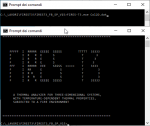 Attached Image.
Attached Image.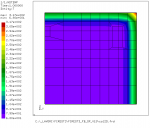
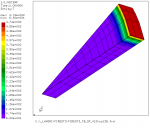 Attached Image.
Attached Image. Attached Image.
Attached Image.


